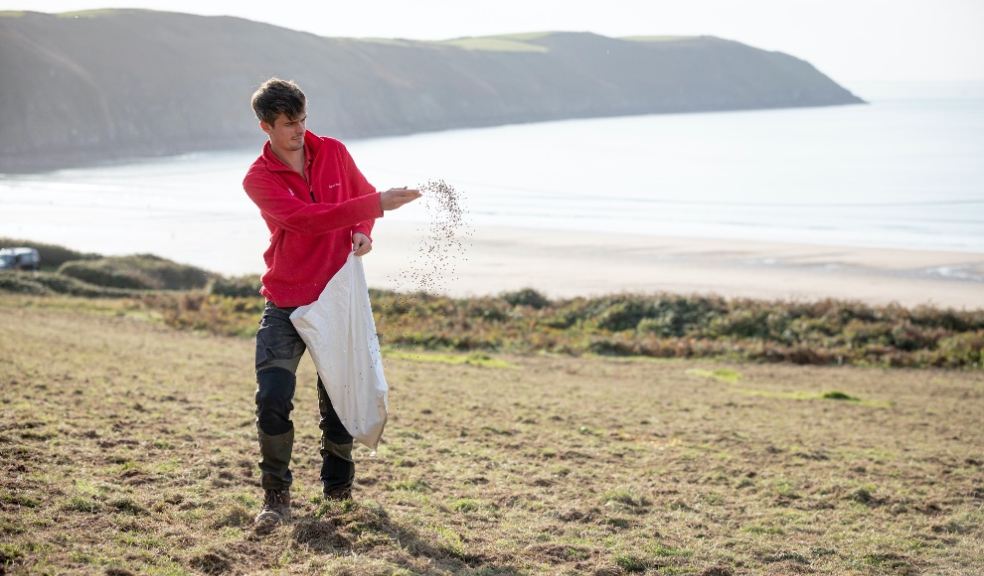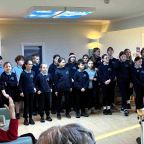
North Devon grassland ‘savannah’ to become largest to be created in the UK
The National Trust has announced its largest ever wildflower grassland project as part of its efforts to help save this threatened habitat and tackle the nature and climate crises.
In a project which will eventually create pockets of species rich grassland across 70 miles of the north Devon landscape, 86 hectares (213 acres) of land has been sown with 1.3 tonnes of specially selected seed over the past few weeks.
These fields, an area equivalent to 120 football pitches, will become ‘donor’ sites for the remainder of the project over the next eight years.
As part of the conservation charities ambitions to improve habitats for nature which benefit both wildlife and people, the project will be scaled up year-on-year to eventually improve the wildflower diversity of 1,275 hectares (3,151 acres) of grassland, equivalent to 1,786 football pitches.
Joshua Day, Project Co-ordinator at the National Trust in north Devon said: “Ninety-seven per cent of species rich grasslands – the equivalent to 4.5 million acres – have been lost nationally over the last 100 years with only one per cent remaining today.
“This has had a devastating impact on our native wildflowers with once common species such as eyebrights and Cowslips becoming ever rarer, and a disastrous impact on the species that are reliant on these flower rich habitats such as bumble bees and other pollinators.
“However, lowland grassland creation is a very effective and relatively quick way to improve habitats for wildlife and boost biodiversity.”
“For the best chance of success it’s vital to sow the right types of plants in the right places. This will ensure we grow the right complementary wildflowers for the area which will help wildlife that already lives there, as well as attracting new species.”
The team has selected the land for this project by assessing its soil chemistry and suitability to grow different species.
Josh continued: “At one of our first sites at Arlington, we have sown seed for wildflowers such as birdsfoot trefoil and knapweed which are good for hundreds of different insects, but at Woolacombe we’ve sown species such as kidney vetch and viper’s-bugloss to complement the sand dunes and cliff tops, which are good for blue butterflies and especially the small blue which is scarce in the west country.
“Once established, the meadows will also attract a variety of important species such as voles, pollinators and bats.”
The team have sourced seed with a suitable provenance for the first tranche of planting which has been sown using a combination of two different methods – hand sowing and seed broadcasting, according to the ecology of the different sites. The remaining area of land will be sown using seed from the newly created ‘donor’ sites.
Joshua explained: “We’ll leave the grasslands to really establish themselves for a couple of years and harvest the first seed in 2025. Every hectare we harvest from a donor site will provide us with seed to sow two more hectares. This gives us a sort of pyramid effect which means by 2030 we’ll have planted our project area importantly with seed from the local area.”
It is estimated that using donor sites in this way and phasing the project over the next eight years could save the conservation charity over £3 million.
Josh continued: “This type of seed can be really expensive – so harvesting from our own sites is not only cost effective, but also the grassland has the best opportunity to become well established because the seed comes from neighbouring areas. The more local the seed source, the better – both in terms of plant genetics, seed heritage and ecology.
“Careful ongoing management will be needed for successful establishment – grazing with the right animals in the right numbers at the right times of year.”
The creation of the new grassland habitats will help towards the charities ambitions to create 25,000 hectares of priority habitat by 2025.
Ben McCarthy, Head of Nature Conservation and Restoration Ecology at the National Trust added: “The on-going loss of flower rich grasslands has seen the colour drain from our countryside.
“Flower rich hay meadows and pastures are a hugely important habitat that remain under constant threat from a range of pressures including agricultural intensification and inappropriate management. These colourful and species rich habitats are critical to conserving many of our threatened plants as well as the wildlife that rely on them.
“We are leading national efforts for grassland restoration as an integral part of our Nature Based Solutions to tackle the twin crises of climate change and nature’s decline. Making changes to the land we manage ourselves and working with our tenant farmers to restore these wildlife rich grasslands secures better soil health, helps lock in soil carbon and improves water quality in our rivers as well as supporting other wildlife such as pollinators.”
Once the seed starts to grow, sheep will be allowed onto the site to graze to keep the grass short over the winter months. They’ll then be moved to other grazing sites in the spring and the wildflowers allowed to grow tall and bloom from May to August, before returning after the summer harvest.
The team has worked closely with staff at the North Devon Area of Outstanding Natural Beauty (AONB) which has contributed £15,000 to the project. “We are delighted to support this ambitious and important project to make a real difference for both nature and the natural beauty of the area that local communities and visitors value so much,” said AONB Manager Jenny Carey-Wood. “Thanks to National Lottery players, we are able to help fund equipment, training and community involvement with the restoration work[7].”
Rangers have also worked with experts at the Bumblebee Conservation Trust. Jamie Buxton-Gould, Project Officer says: “Bumblebee conservation and grassland conservation go hand in hand, each depending on the other to maintain functioning plant-pollinator networks.
“The north Devon coast is home to some rare bumblebee species, including the Brown-banded carder bee which relies on extensive flower-rich grasslands to survive. This project’s location overlaps with our Westcountry Buzz Project which presents an exciting opportunity to restore large areas of flower-rich habitat at a landscape scale – something which is key for helping the recovery of our pollinators and nature.”











